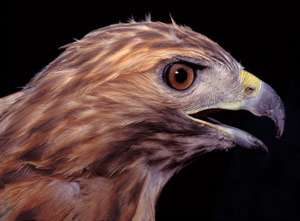While many of us shy away from the sunlight’s ultraviolet (UV) rays, male raptors may rely on that light to find their mates. Research by Francois Mougeot and Beatriz Arroyo from the Center for Ecology and Hydrology in the United Kingdom shows that the cere – the yellow-orange patch of skin above the beak that encompasses the nostrils – of male raptors reflects light in the UV-spectrum, which may help attract females.
Carotenoids – pigments that fall between yellow and red on the spectrum – that the bird ingests are responsible for the orange color of the cere. They are also responsible for the reflection of light in the UV spectrum. The chemicals reflect light in UV wavelengths, while the structure of the molecule itself determines the specific wavelength of UV light reflected. A cere that is richer in color, meaning that it contains more carotenoids, reflects a more intense UV light. The richness of the cere’s color is also related to the male raptor’s body mass and condition. Those with richer ceres are usually larger and stronger, with color also varying depending on what the raptor eats.
It has long been known that raptors use their cere to get the attention of the females. The more orange the cere, the more worthy the male. Studies have also shown that many species of birds can detect near-ultraviolet light and will use UV reflection from plumage to help in mate choice. Scientists are finding evidence that the UV reflection from the fleshy parts of birds – combs on the grouse and chicken or wattles on the turkey – could be related to sexual signaling. In this study, the scientists combined these three findings and decided to test whether a raptor’s cere would reflect light in the UV spectrum and therefore have a greater effect on female mate choice.
Using a spectrophotometer, Mougeot and Arroyo measured the wavelengths of light reflected from the Montagu’s harrier’s cere from an imposed halogen light source and found that it does, indeed, reflect light in the UV range. As for sexual signaling, raptors with richer ceres – and greater UV reflection – were in earlier-breeding pairs. Males that had the lowest cere richness (and least UV reflection) either bred late or did not breed at all. Raptors that breed earlier in the season usually have a greater rate of nesting success. During courtship, most male raptors will feed their mates, and the timing of the egg laying depends on the amount of food the female has received – those with more food will lay earlier. This could mean that there is also a correlation between how richly colored the cere is and the male’s ability to gather food.
Although this study found that cere richness, UV reflection, and breeding are correlated, more research will have to be done before confirming that UV-reflectance from a raptor’s cere helps attract the females of the species. For example, the female Montagu’s harrier has not yet been specifically tested for UV vision, which is a crucial piece of the puzzle.


